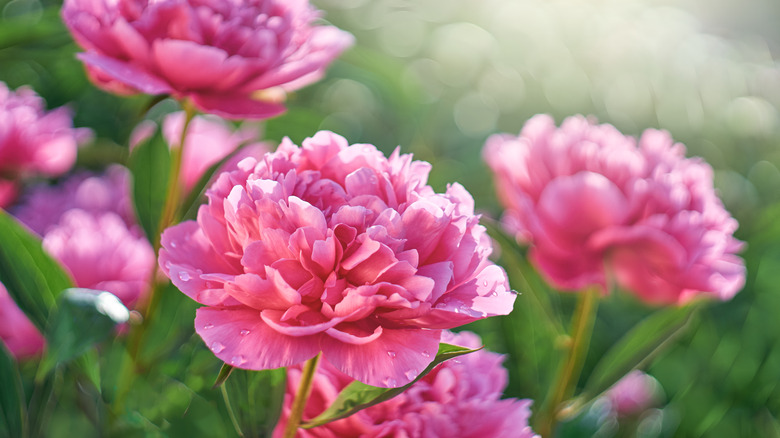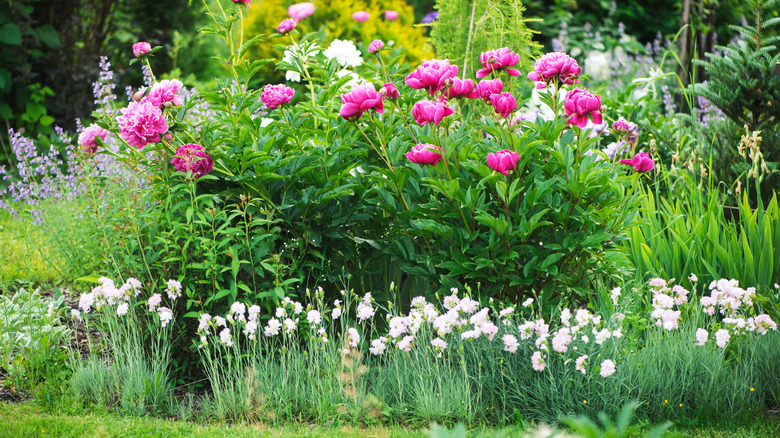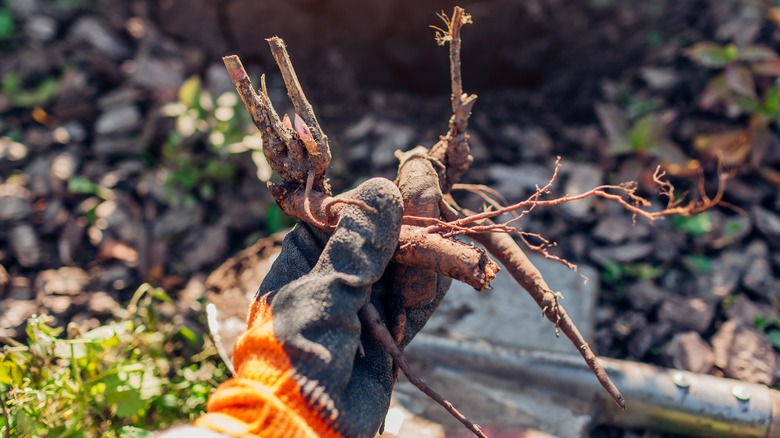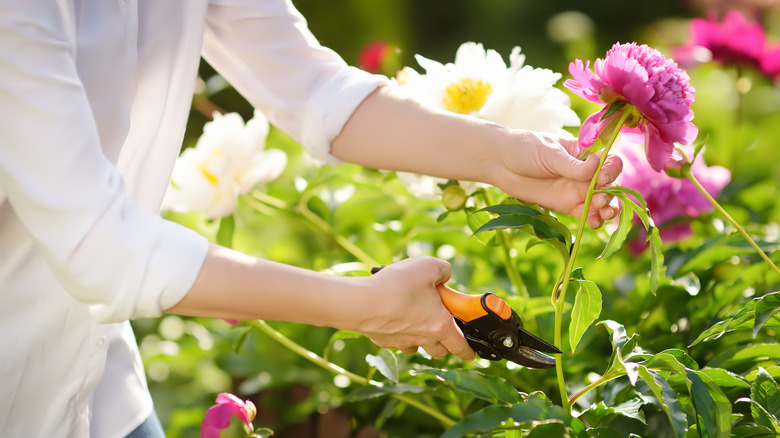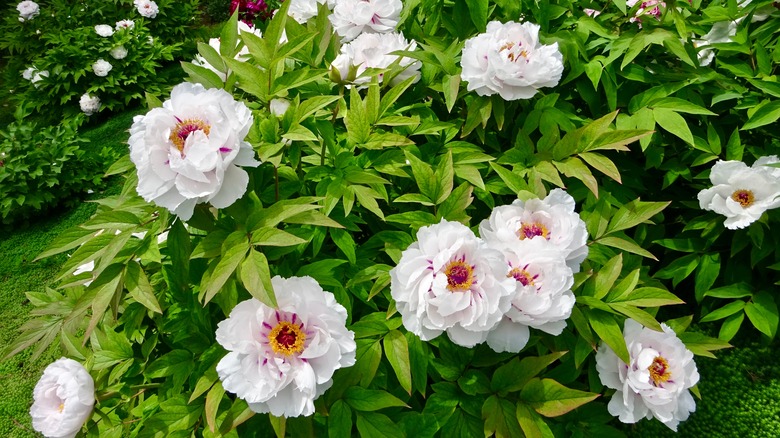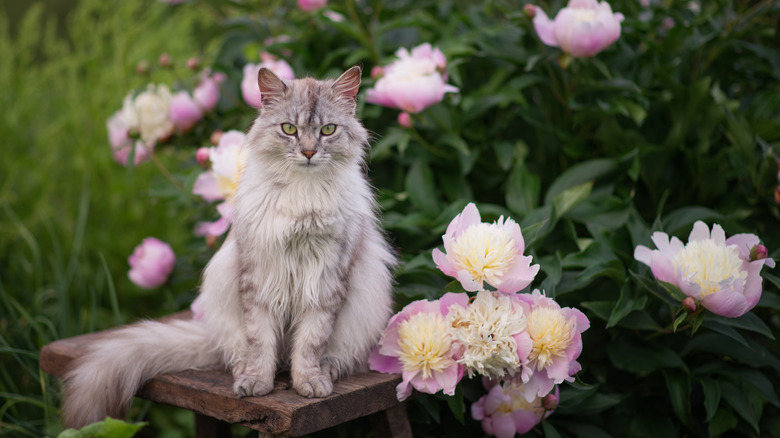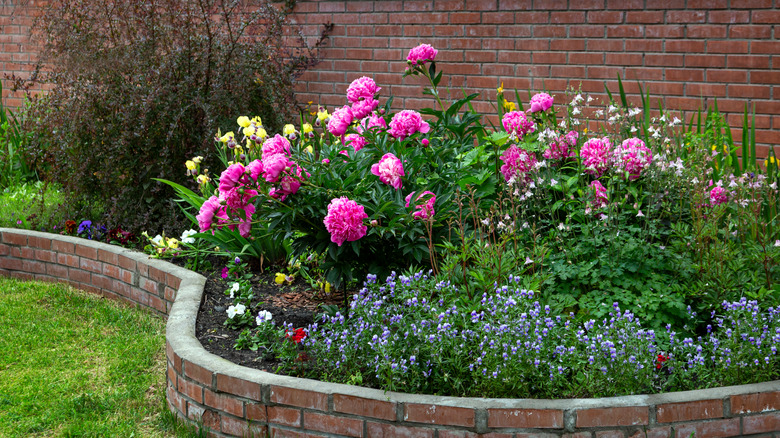How To Successfully Grow Peonies
Peonies, or Paeonia, add a sense of drama and beauty to any garden with their large but dainty flowers and lush foliage. These plants bloom in the late spring and summer, producing large flowers reaching up to ten inches wide in a wide range of shapes and colors ranging from pure white to deep red. The flowers also have a wonderful aroma that varies depending on the variety of plant. This perennial plant has three types, including tree, herbaceous, and intersectional. The most popular variety, herbaceous peonies, is easy to care for and perfect for flower cuttings.
Native to Asia, Europe, and Western North America, peonies do well in most climates, although they prefer colder winters so their root systems can establish, explained The Spruce. Peonies can live for over 100 years, making them the perfect plant to pass down in your family. Growing several feet high, these plants and their spectacular blooms are a beautiful addition to any garden.
How to use peonies in your garden
Planting peonies in your garden is a fantastic way to add tons of beauty and color to your space. These plants truly stand out amongst your other garden plants with huge, colorful, fragrant blooms. Cricket Hill Garden described how to use peonies in your garden to create a space you will love.
Large shrubs, such as tree peonies, make great borders in your garden and using different varieties that bloom at different times can help you have flowers for longer. Or use different varieties to add varying heights, colors, and fragrances to your garden. You can also add more variety by planting other perennials and annuals along with your peonies. Keep in mind when you are designing your garden that peonies only bloom for a few weeks, but their foliage is just as beautiful and makes an excellent background for other colorful flowers. You can also feature peonies on their own in pots or raised beds to really showcase their blooms in your garden.
How to grow peonies
Growing peonies is quite simple, although it may take a few years until you see those beautiful blooms, according to Garden Design. Since there are three varieties of peonies, herbaceous, tree, and intersectional, make sure to check specific growing instructions for your type, as they may vary slightly. Generally, these plants do best when planted in the fall before the ground freezes. Take care to plant your peonies in an area that will receive full sun. Although peonies can survive in partial sun, they thrive in at least 6 to 8 hours of sun a day. Also, because peony blooms can be so large, they need to be relatively sheltered from the wind so they don't blow over.
When planting peonies, you will usually be planting a root tuber with a few buds on it. First, dig a large hole, a few feet deep by about a foot wide, adding some compost to the hole if the soil is heavy or sandy. Make sure you are planting your peony tubers in well-draining soil. Set the root tuber in the hole with the buds facing up and refill the hole. Water the area after tamping the soil. Plant your peonies 3 to 4 feet apart in your garden for optimal growth.
How to care for peonies
Peonies are relatively easy perennial plants that require little maintenance throughout the year, per Almanac. As long as they are in full sun, you will see beautiful blooms throughout the spring and summer months. Peonies don't need to be watered often and can usually survive on rainfall alone. They also don't need to be fertilized regularly, usually once every few years is perfect for these plants.
The primary maintenance that peonies require is support and deadheading. Because of their large blooms, herbaceous peonies can get a bit top-heavy, and therefore having a support structure in place will help keep them stabilized and allow them to grow beautifully. You can use specific peony rings, usually metal supports with three legs, or you can use tomato cages. If you have a tree peony type, you won't need to worry about support as much.
Peonies also need to be deadheaded when their blooms start to fade so new flowers can take their place. To do this, simply cut back the stem of the faded bloom. Because there are several varieties of peonies, care instructions may vary slightly, so make sure to research your specific variety's care instructions.
Peony varieties
Home for the Harvest explained the three different types of peony plants and some varieties within each type.
Herbaceous peonies are the most popular and the easiest to care for. The large colorful flowers make them great for cuttings, but you want to ensure they have support because the stems aren't strong enough to support the top heavy blooms.
-
Coral Charm Peony: These breathtaking flowers are bright pink and bloom in the early spring.
-
Goldilocks Peony: This variety is pale yellow and features a beautiful bundle of delicate petals.
-
Shirley Temple Peony: Light pink in color, these peonies will add some beauty to any garden.
Tree peonies are sturdier and have woody stalks like trees. They produce large flowers but don't need to be supported. The flowers last longer than the herbaceous type, and the stalks remain standing throughout the winter.
-
Renkaku Tree Peony: These peonies have blooms with delicate white petals and yellow centers.
-
High Noon Tree Peony: With bright yellow blooms, these peonies are sure to stand out.
-
Koukamon Peony Tree: This variety of tree peonies features deep red-purple blooms.
Intersectional peonies, also called Itoh peonies, are a hybrid between herbaceous and tree peonies. These plants bloom later than herbaceous and are more tolerant to the cold.
-
First Arrival Itoh Peony: These beautiful pink flowering plants feature large blooms with yellow centers.
-
Kopper Kettle Itoh Peony: These flowers have a unique copper/rust color.
-
Prairie Charm Itoh Peony: This variety features large yellow blooms with darker-colored centers.
Are peonies toxic?
Peonies can be a stunning addition to your garden, but Hobby Farms warned that they aren't necessarily safe to ingest. Peonies won't cause harm to humans in small quantities, but it is recommended to avoid consuming them in large quantities as they may cause rashes, nausea, vomiting, or diarrhea. Even though peonies won't cause immense harm to humans in small amounts, it is still recommended to plant them in an area where young children won't have easy access to them.
Although peonies are relatively safe for human consumption, they are toxic to both dogs and cats and can cause severe harm to your pets. Your pets may experience vomiting, diarrhea, or depression from ingesting peonies. If they consume large quantities of peonies, your pet will need immediate veterinary attention for their safety. Because of their toxicity to pets, it is best to plant peonies in an area where your pet cannot access them.
How to repot peonies
You can grow your peonies in a large pot, at least 12 inches in diameter, or in the ground in your garden. Despite many believing that peonies can't be transplanted or repotted, Homes & Gardens explained that it is possible, as long as you take certain precautions. It is true that peonies are temperamental when it comes to moving, but they can survive a move if it is done correctly. You may notice that your peonies don't bloom the spring following their move but should resume their typical blooms the following year.
The first step of repotting or transplanting your peonies is to gently dig them out of the soil, being careful not to disturb their roots too much. Once the plant is lifted, you can plant it in a different area of your garden or divide them by cutting where the roots are formed and have at least three buds. These roots can be planted in another pot or area of your garden. If you want to replant your peonies in the same hole, make sure to remove all the soil and add new soil. Following these few steps will ensure that your peonies survive their repotting.
